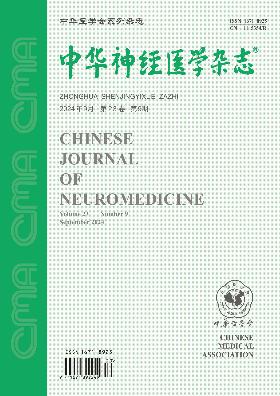Establishment of prognosis prediction scale for aspirin combined with clopidogrel in acute cerebral infarction and preliminary evaluation of its prediction effectiveness
Q4 Medicine
引用次数: 0
Abstract
Objective To establish a prognosis prediction scale for aspirin combined with clopidogrel in treatment of acute cerebral infarction (ACI) and evaluate its prediction effectiveness. Methods A retrospective analysis of clinical features of 202 ACI patients, admitted to and accepted aspirin combined with clopidogrel in our hospital from October 2017 to April 2019, was performed. According to the differences of National Institutes of Health Stroke Scale (NIHSS) scores before and after treatment, the patients were divided into good prognosis group and poor prognosis group; univariate and multivariate Logistic regression analyses were used to screen the independent risk factors for prognoses of acute cerebral infarction; assignment of these factors was performed, respectively, to establish prediction scale; and finally the prediction scale was applied to the patients for verification. Results Of the 202 patients, 167 had a good prognosis and 35 had a poor prognosis. Multivariate Logistic regression analysis revealed that age≥50 years, hypertension, homocysteine, and carotid stenosis≥50% were independent risk factors for prognoses 14 d after onset in patients with ACI (P< 0.05); the assigned values of age≥50 years, hypertension grading I, hypertension grading II, hypertension grading III, homocysteine, and carotid stenosis≥50% were 1, 1, 2, 3, 1, and 1, respectively; the total pridiction scale scores were 0-6. Validation results showed that the poor prognosis rate of patients with predictive scale scores≥3 was 91.3% (157/172) and that of patients with predictive scale scores<3 was 33.3% (10/30). Conclusion The predictive scale established in this study can be used to quickly and accurately identify patients with acute cerebral infarction who are suitable for aspirin combined with clopidogrel. Key words: Cerebral infarction; Aspirin combined with clopidogrel; Prognosis; Prediction scale; Influencing factor阿司匹林联合氯吡格雷治疗急性脑梗死预后预测量表的建立及其预测效果的初步评价
目的建立阿司匹林联合氯吡格雷治疗急性脑梗死(ACI)的预后预测量表,并评价其预测效果。方法回顾性分析2017年10月至2019年4月我院收治并接受阿司匹林联合氯吡格雷治疗的202例ACI患者的临床特征。根据治疗前后美国国立卫生研究院卒中量表(NIHSS)评分的差异,将患者分为预后好组和预后差组;采用单因素和多因素Logistic回归分析筛选影响急性脑梗死预后的独立危险因素;分别对这些因素进行赋值,建立预测量表;最后将预测量表应用于患者进行验证。结果202例患者中,预后良好167例,预后不良35例。多因素Logistic回归分析显示,年龄≥50岁、高血压、同型半胱氨酸、颈动脉狭窄≥50%是影响ACI患者发病后14 d预后的独立危险因素(P< 0.05);年龄≥50岁、高血压I级、高血压II级、高血压III级、同型半胱氨酸和颈动脉狭窄≥50%的赋值分别为1、1、2、3、1和1;预测量表总分为0-6分。验证结果显示,预测量表评分≥3的患者预后不良率为91.3%(157/172),预测量表评分<3的患者预后不良率为33.3%(10/30)。结论本研究建立的预测量表可快速、准确地鉴别急性脑梗死患者是否适合阿司匹林与氯吡格雷联用。关键词:脑梗死;阿司匹林与氯吡格雷联用;预后;预测规模;影响因素
本文章由计算机程序翻译,如有差异,请以英文原文为准。
求助全文
约1分钟内获得全文
求助全文
来源期刊

中华神经医学杂志
Psychology-Neuropsychology and Physiological Psychology
CiteScore
0.30
自引率
0.00%
发文量
6272
期刊介绍:
 求助内容:
求助内容: 应助结果提醒方式:
应助结果提醒方式:


